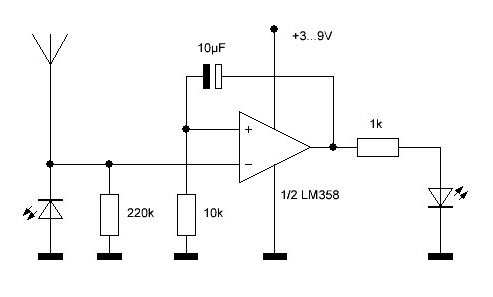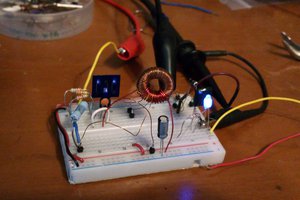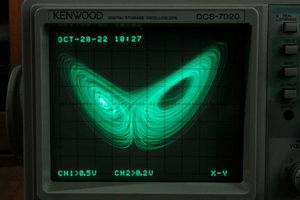The circuit

Functional description
The function is triggered either by a light pulse on the yellow LED (as a photodiode), by touching the input or by an electromagnetic pulse. After that, there is a pause of about half a second. And then there is a sound, which at first reminded me of the unwilling meowing of a cat, which does not want to be disturbed. One understands it intuitively, the cat says: "Leave me alone, I want to sleep!"
We make similar noises when we feel disturbed. Everyone knows the situation. You are sitting concentrated at work and someone comes in, the flow of work and concentration are disturbed. At first, you don't want to be rude and you stay quiet for a moment. But then the internal pressure increases and you say "Oh!", or "No!" or even "Crap!". No matter what you say, it always has the same reproachful sound with descending frequency at the end. And everyone understands that there's more to it than just a word, namely, "I want to do creative work here, and you just come in and bother me! Don't you have anything to do? Just get out again!" Everyone understands, except that one colleague who sees his job as keeping others from working because he himself never works properly.
If you now try to reproduce this behavior in the circuit diagram, you may have some difficulties. If now all say, this can never work, my goal is reached. I wanted to build a circuit that is difficult to understand. And at the same time it should perform a complex function with as few components as possible.
Trigger circuit
The first part of the circuit is a very sensitive triggered monostable flipflop with an additional slow falling back edge. I came across the principle by accident when working with an LM358. With a LM324 it works as well. It is essential that this op amp has a PNP input stage, with which the inputs work down to the GND level and even a bit below. These types were developed for use with single operating voltages from 3 V.

The two inputs have a base current of approx. 20 nA. An open input would be pulled up. So I can generate a bias voltage via the voltage drop at a resistor to GND, similar to what was done at some old tube circuits. At the -input I use 1 MΩ, so there is a voltage of + 20 mV here. In a separate experiment you can also use 220 kΩ to make the circuit even more sensitive. The +input gets only 10 kΩ and therefore has only 0.2 mV, so it is almost at GND. As the -input is clearly higher than the +input the output stays at the bottom. However, a very small negative voltage spike of about 20 mV is enough to drive the output high. In that case, the capacitor charges up and pulls the +input high. This keeps the output high for a longer time, just like a normal monoflop. By the way, the time is much longer than the time constant 10 µF * 10 kΩ = 10 ms, because the voltage has to drop below 20 mV to end the pulse.
If an LED is connected to the output, it turns on for about half a second with each trigger event. Triggering is done e.g. with a light pulse to the left LED, which acts as a photodiode. A yellow LED has proven itself well here. With full light it can generate a voltage of more than 1.5 V. The cathode is at the input here, so a negative voltage is output. In fact, it only needs to deliver a little more than 20 nA to compensate for the input current of the OPV. It easily manages this with the light beam of an LED flashlight, which briefly wanders over the sensor LED.
A wire antenna is as well connected to the input. If one touches the bare wire, usually some interference voltage is coupled in. A few millivolts are enough to trigger the circuit. The same thing happens with an electromagnetic pulse when you flip a light switch, for example. Or you can use a piezo lighter at a distance of 10 cm. The electric spark will generate the necessary pulse. A simple lighter with a flint also works because the bright flash of light is...
Read more » Burkhard Kainka
Burkhard Kainka



 Adam Oakley
Adam Oakley
 Chris Johnson
Chris Johnson
 CheeenNPP
CheeenNPP
Very simple and interesting circuit. What will happen if we replace LM358 with a LF353? Both are pin compatible dual op amps.